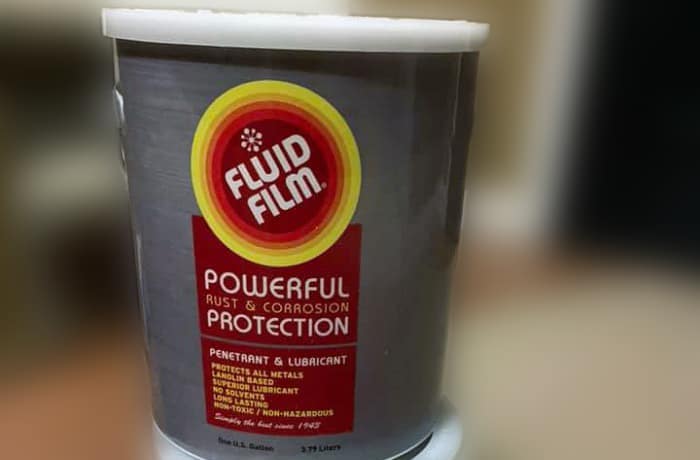Fluid Film is a standout solution for combating corrosion, especially on vehicle frames that endure harsh conditions.
Originating from lanolin, the natural grease found in sheep’s wool, Fluid Film is a powerful barrier against moisture and salt, two of the primary culprits behind rust formation.
This feature makes it particularly beneficial for vehicles frequently exposed to wet climates or salted roads during winter.
By creating a durable, non-drying layer, Fluid Film preserves the frame’s metal and enhances its longevity, providing vehicle owners with peace of mind and reduced maintenance costs.

Table of Contents
1. Preparation of the Rusty Frame
Proper frame preparation is crucial to maximizing the effectiveness of Fluid Film. Here’s how to ensure that the frame is ready for treatment:
Cleaning the Frame
Removing Rust and Debris
Begin by addressing any loose rust and debris. For light rust, a wire brush is sufficient to clean the surface. If the rust is more severe, sandblasting may be necessary to achieve a clean, bare metal surface that is ideal for treatment.
Degreasing the Frame
After removing the rust, wash the frame thoroughly using a degreaser or a simple soap and water mixture. This step is vital for removing any residual grease, oil, or dirt that could prevent Fluid Film from adhering correctly.
Rinse the frame well and allow it to dry completely, ensuring no moisture is left, as this could lead to further corrosion under the protective coating.
Assessing Rust Severity
Assess the extent of the corrosion before applying any protective coatings. Fluid Film is highly effective on surface rust that hasn’t penetrated deeply into the metal.
However, additional repairs might be needed before treatment if the rust has led to significant structural damage or pitting. Fluid Film excels in preventive scenarios and is best used before rust compromises the frame’s structural integrity.
2. Application of Fluid Film
The application process is straightforward but requires attention to detail to ensure thorough coverage and optimal protection.
Equipment Preparation
For a comprehensive application, you can use a spray gun, which offers a more controlled and even coating, especially for larger areas.
Aerosol cans of fluid film may be more convenient for smaller or more intricate frames. Ensure that whatever method you choose can effectively reach all nooks and crannies of the frame.
Applying Fluid Film
Stirring or Shaking
Before application, it’s crucial to stir or shake the product thoroughly. This ensures that all the active ingredients are evenly distributed within the solution, providing consistent protection across the entire frame.
Coating the Frame
Apply a generous coat of Fluid Film to the entire frame, covering every surface. Particular attention should be paid to welded joints and crevices, common starting points for rust.
The unique formulation of Fluid Film allows it to seep into these hard-to-reach areas, offering enhanced protection.
Reaching Difficult Areas
Use a brush or sponge for any difficult areas to reach with a spray. This ensures that even the most hidden parts of the frame are protected.
Setting and Layering
After applying the first layer, allow it to penetrate the rust and set it for a few hours. A second layer might be necessary if the frame is in a particularly harsh environment or if you desire a thicker protective barrier.
This extra step ensures a more robust coating, which enhances Fluid Film’s rust-prevention capabilities.
3. Post-Application Care
After applying Fluid Film, proper post-application care is essential to maintain its effectiveness and prolong the frame’s protection against rust.
Drying Time
Fluid Film does not dry completely but remains slightly tacky to the touch. This characteristic is crucial as it allows the product to repel water and resist being washed off continually.
It’s important to note that while Fluid Film will feel tacky, this is a typical coating property and part of what makes it so effective at moisture resistance.
Inspection and Maintenance
Regular Checks
It is recommended that the frame be inspected regularly, especially after exposure to severe conditions like salt spray or extensive mud, which are common in off-road driving or winter climates.
Checking the frame allows you to spot areas where the Fluid Film might have been compromised or needs reapplication.
Annual Reapplication
Depending on your vehicle’s exposure to elements and the thickness of the initial application, it may be necessary to reapply Fluid Film annually. This ensures that any areas naturally worn away by exposure, or mechanical action is once again protected.
Conclusion
By following these detailed steps—from preparing the rusty frame to applying and maintaining Fluid Film—you can effectively safeguard your vehicle against the persistent threat of rust.
Fluid Film’s unique, lanolin-based formula offers a robust defense, ensuring that your vehicle’s frame remains in excellent condition despite exposure to moisture and salt.
Regular application and maintenance of Fluid Film extends the lifespan of your vehicle’s frame and enhances its overall safety and integrity, making it a wise and cost-effective measure for any vehicle owner.
